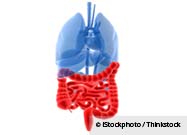Story at-a-glance
- Microbes in your gut can change profoundly throughout your life, and you can change them through diet, medications, and hygiene.
- Five strategies to help improve your gut flora include avoiding antibiotics, eating more whole plant foods and fermented foods, opening a window to the outdoors, and working in your garden.
- The American Gut Project will evaluate how different diets impact gut flora, and in turn how different gut flora impacts your health. Deadline for signup is February 2, 2013.
- The profound breakthrough technology that was used to sequence the human genome can now help you know what type of bacteria are living in your intestine.
Most Popular
You Might Also Like
Five Strategies for a Healthier Gut in 2013
January 24, 2013 |64,890views| + Add to Favorites
| 324 |
Print
|
By Jeff Leach
In the summer of 2008, a 26-year-old man from Shanxi Province walked into a lab at Shanghai Jiao Tong University, and 23 weeks later walked out 113 pounds lighter.
He had not participated in a clinical trial of some new secret weight loss pill, or signed up for a punishing Biggest Loser-style exercise program, nor had he been fussed over by behavioral scientists who made his plates and drinking cups smaller with each passing week.
The researchers, who were microbiologists, had simply put the man’s gut microbes on a diet.
One of the huge mysteries in studies of diet and exercise is the difference between people who get the same treatment but have remarkably different outcomes. Inevitably, some people in a study show little improvement despite weeks or even months of following what might seem like draconian changes in their normal diet and lifestyle.
Other people apparently drop weight just by getting out of bed in the morning, and also improve their circulating triglycerides, total cholesterol, and biomarkers of inflammation with apparent ease. We all know someone like this in our daily life.
But why are there such extreme differences between people?
Is your DNA to blame?
Our human genes may be involved in some cases but we generally share more than 99 percent genetic similarity with other people; more interestingly, the huge differences in peoples weight gain/loss may be driven more by the different bacteria in our intestines, which can be more than 90 percent different between one person and the next.
In addition to the familiar human genome that we inherit from our moms and dads, each of us also has hundreds of trillions of microbial symbionts, each with their own genomes. Research programs such as the Human Microbiome Project1 have revolutionized our understanding of our microbial bodies, which outnumber our human cells 10 to one, and account for more than two pounds of your body weight. We know microbes in your gut can change profoundly throughout life, and that you can change them through diet, medications, and hygiene, for example.
We also know that how you enter this world – C-section versus vaginal birth – can impact your initial “seeding” of microbes,2 which further change during breast- or formula-feeding, and what you eat later in life also affects your gut microbes and even how healthy you are as a senior citizen.3 We know that people in more traditional societies have different microbes than those in more Westernized populations,4 and that diet can play a role in these differences. You can also change the health prospects of a mouse overnight by changing its diet and thus its microbes.
The American Gut Project Seeks Valuable Answers
Advances in bioinformatics (fancy word for data analysis) and refinements of DNA techniques – not to mention a significant increase in computing power – is changing everything. The evidence that life events and diet can shape our gut microbes is increasing, but which direction should we nudge them? What is a healthy or optimal mix of gut microbes?
The honest answer is nobody knows (yet), but projects are underway – that you can participate in – to help us to better understand the role bacteria play in our health and lifestyle. The American Gut Project5 is one of the most ambitious of these projects, and I encourage you to join, to learn more about your own gut, and how it’s affecting your health. The deadline is February 2. To learn more, and for instructions on how to participate, please see Dr. Mercola’s article: “American Gut” - One of the Most Important Health Projects of the 21st Century.
The project is crowdfunded, meaning it’s funded by volunteer donations. In return, you get certain “Perks,” which include:
Here’s a summary of how many sampling kits you receive with your donation (The entire cost below goes directly to the Project). Kits will be mailed out starting in February, 2013:
- A list of the dominant microbes in your gut
- Visualizations showing how you compare to the general population
- Charts showing the dominant kinds of microbes along with descriptions of what they are most associated with
- If your donation covers multiple sample kits, you may be able to see how your microbes change over time (if all the samples are from you), or how your microbes compare to those in your family members, for example
The kits contain pre-labeled test tubes and instructions for how to properly collect your samples. Each sample must be mailed to the University of Colorado within 48 hours of collection. (You will be responsible for the postage: $1.95 per sample.)
- $99 — One kit, which can be used for either a stool, skin or oral sample
- $180 — Receive two kits, which can be used by yourself, either by sending in two different types of samples (stool and oral sample, for example), or by sending them in at different times to see how your microbes change over time. Or the kits can be used to send in one type of sample from two different people
- $260 — Receive three kits
- $320 — Receive four kits
- For donations of $500 and over, please see the American Gut Project IndieGoGo website
Five Strategies to Improve Your Gut Health
In the meantime, as you contemplate your New Year’s resolution to join the gym (again), lose weight, improve your diet, or to purchase the latest gizmo to track your every move, you might want to consider whether your microbes will support your decision. After all, they’re in control. Below are five suggestions on how you might improve the health of your gut microbes (and some other microbes in your life) in 2013.
- Avoid antibiotics. It’s a familiar story by now: overzealous use of antibiotics are driving antibiotic resistance among microbes at an alarming rate. But it gets worse: the average child in the developed world will likely receive 10-20 courses of antibiotics before his or her 18th birthday. This, coupled with the low therapeutic doses in animal feed – and ipso facto food, may be shifting our gut microbes into an unhealthy state and possibly contributing to the metabolic disease of obesity.6
It’s also well documented that following a course of broad-spectrum antibiotics, it could take weeks, months or even years for your gut microbial community to bounce back – if at all. During this period of imbalance, opportunistic pathogens can set up shop. Or worse. While antibiotics are clearly needed in some scenarios, ask more questions in 2013 before downing them without a care.
- Open a window. For 99.99 percent of human history the outside was always part of the inside, and at no moment during our day were we ever really separated from nature. Today, a National Activity Survey7 found that between enclosed buildings and vehicles, modern humans spend a whopping 90 percent of their lives indoors.
Though keeping the outside out does have its advantages – protection from the elements and decreasing your chances of being eaten by a zombie – it has also changed the microbiome of your home. Studies8 show that opening a window and increasing natural airflow can improve the diversity and health of the microbes in your home, which in turn benefit the inhabitants. In the not-so-distant future, building codes will likely reflect the biological benefits of rewilding our living and workspaces. Never hurts to get a head start.
- Adopt an ecological perspective. In 2013, familiarize yourself with the writings of Aldo Leopold, John Muir, and other important and interesting – past and present – naturalists and ecologists. The human-microbial superorganism is a vast ecological system, subject to the same rules of resistance, resilience, and balance as any ecosystem on the planet. The sooner you learn to tend your microbial garden, the sooner you will understand how human ecology and your health is nothing more than understanding our history and place in the larger biosphere.9
- Eat more plants. This is not a hard one. I don’t mean to give up meat, but I mean to eat a greater diversity and quantity of whole plants. This is the single most important (in my opinion) dietary strategy for improving the diversity and health of your gut microbiome. In short, your gut microbes thrive on a diversity of fermentable substrates (aka dietary fiber). But not all fiber is the same (physically or chemically), so consuming a diversity of whole plants will assure as steady flow of substrates for your resident microbes.
And make 2013 the year you eat more of the whole plant, not just the soft and tasty parts. Consume the entire asparagus, not just the tip; consume the trunk of the broccoli, not just the crown; consume all of the greens at the top of the leek, not just the bulb. By doing so, you will guarantee that the harder-to-digest portions of the plant will extend the metabolic activity of your microbiome deep into your bowels. Also track how many species of plants you eat in a week – shoot for 30-40, or more.
- Get your hands dirty. More to the point: start a garden. Getting your hands dirty and covering more of your body (and food) with mother nature’s blanket will help you not only connect with the natural world we have tried so hard to remove ourselves, but will reacquaint your immune system with the trillions of microorganisms on the plants and in the soil. The loss of this interface with the terra firma of our evolutionary past – body to soil, body to nature – is where the wheels came off the wagon.
As people of the world move from poverty to middle class, they also move from the gritty reality of our ancestral life to the promise of modern development and its triple-washed produce and squeaky-clean surroundings. Reconnecting with ecosystems, through gardening or some other ‘outside’ means, will allow you to understand and manage your inner-ecosystem. There is no better way.












No comments:
Post a Comment